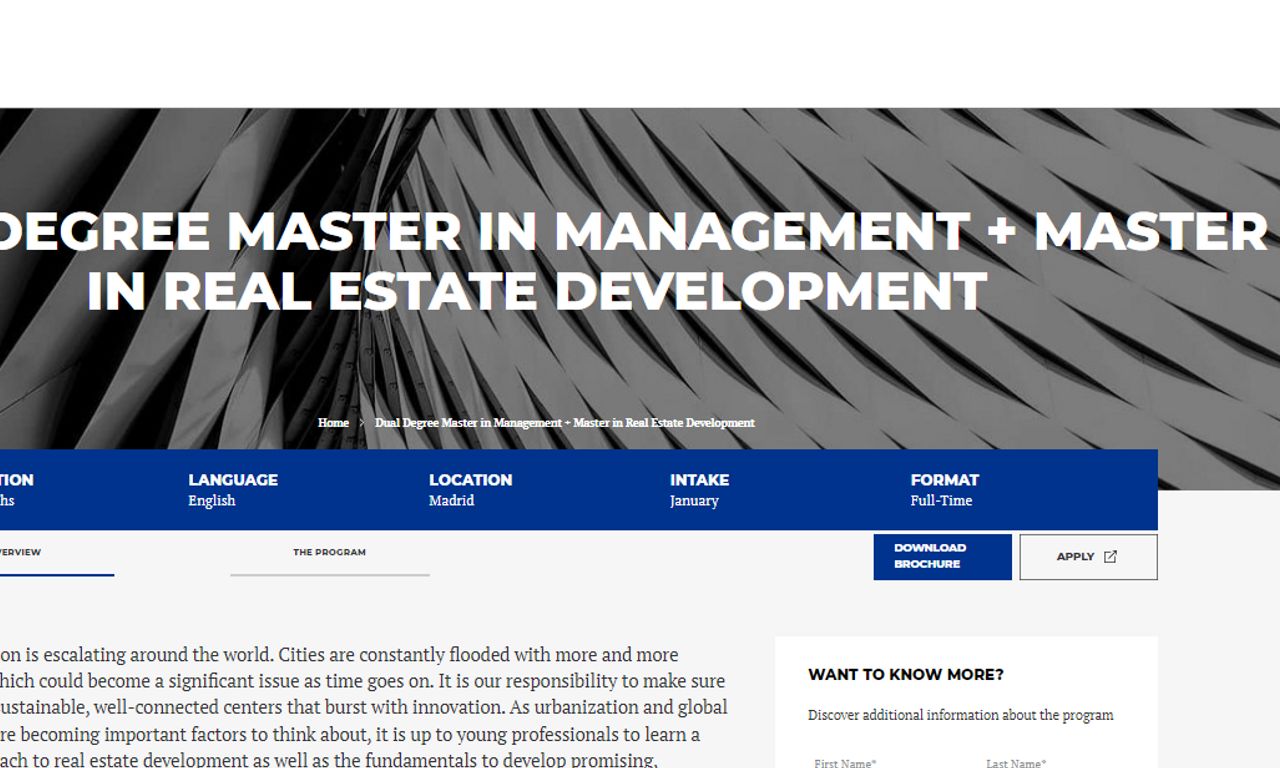MBA in real estate development programs offer a unique blend of business acumen and real estate expertise, preparing graduates for leadership roles in a dynamic and lucrative industry. These programs delve into finance, investment strategies, market analysis, legal frameworks, and sustainable building practices, equipping students with the comprehensive skills needed to navigate the complexities of real estate development. This guide explores the curriculum, career paths, and market trends associated with this specialized MBA.
From understanding financing options and investment strategies to mastering legal and regulatory aspects, an MBA in real estate development provides a solid foundation for a successful career. The program also emphasizes networking and industry connections, opening doors to valuable mentorship and potential job opportunities. Ultimately, graduates are poised to contribute significantly to the ever-evolving landscape of real estate development.
Program Overview
An MBA in Real Estate Development is a specialized graduate program designed to equip students with the business acumen and real estate expertise needed to succeed in the dynamic world of real estate. This intensive program blends traditional MBA coursework with focused instruction in real estate finance, development, law, and investment. Graduates are well-prepared for leadership roles across the spectrum of the real estate industry.
Typical Curriculum of an MBA in Real Estate Development
A typical curriculum covers a broad range of topics, integrating core MBA principles with specialized real estate knowledge. Expect courses in areas like financial modeling for real estate, real estate law and regulation, development feasibility analysis, construction management, real estate investment analysis, market analysis, and property valuation. Many programs also incorporate case studies, simulations, and real-world projects to provide hands-on experience.
Electives might focus on specific areas like sustainable development, affordable housing, or international real estate.
Specializations Offered in MBA in Real Estate Development Programs
Different programs offer varying specializations, reflecting the diverse facets of the real estate industry. Some programs might offer concentrations in areas like real estate finance, focusing on capital markets, investment strategies, and risk management. Others might emphasize real estate development, with a curriculum geared towards project management, construction, and land acquisition. A third type of specialization might focus on real estate investment, equipping graduates with the skills to analyze investment opportunities, manage portfolios, and navigate complex transactions.
The choice of specialization depends on individual career goals and interests.
Career Paths Available to Graduates
Graduates of MBA in Real Estate Development programs are highly sought after by a wide range of employers. Possible career paths include roles in real estate development firms, investment banks, private equity firms, real estate investment trusts (REITs), government agencies, and consulting firms. Specific job titles might include real estate analyst, development manager, investment manager, asset manager, project manager, and urban planner.
The advanced analytical and managerial skills gained during the program open doors to leadership positions and entrepreneurial ventures.
Comparison of Three Universities Offering an MBA in Real Estate Development
| University | Tuition Cost (Approximate) | Location | Program Length |
|---|---|---|---|
| Massachusetts Institute of Technology (MIT) | $100,000+ | Cambridge, MA, USA | 2 years |
| University of Southern California (USC) | $80,000+ | Los Angeles, CA, USA | 2 years |
| New York University (NYU) | $90,000+ | New York, NY, USA | 2 years |
Admission Requirements and Application Process: MBA In Real Estate Development
Getting into a top-tier MBA in Real Estate Development program is competitive, but with careful planning and a strong application, it’s achievable. This section Artikels the typical requirements and walks you through the application process. Understanding these steps will significantly improve your chances of acceptance.Admission requirements generally include a strong academic record, relevant work experience, GMAT or GRE scores, letters of recommendation, and a compelling application essay.
The specific requirements vary between institutions, so always check the individual program’s website for the most up-to-date information.
Typical Admission Requirements
Successful applicants typically possess a bachelor’s degree from an accredited institution, a strong academic record (GPA above 3.0 is often preferred), and significant professional experience, often three to five years in a relevant field such as real estate, finance, or construction. Many programs require or strongly recommend GMAT or GRE scores, with competitive scores generally falling above the 70th percentile.
Strong letters of recommendation from individuals who can attest to your abilities and potential are also crucial. Finally, a well-written application essay showcasing your motivations, experiences, and career goals is essential for demonstrating your fit with the program.
Step-by-Step Application Guide
The application process typically involves several steps. First, research and select programs that align with your career aspirations and academic preferences. Next, thoroughly review each program’s specific requirements and deadlines. Then, prepare all necessary application materials, including transcripts, test scores, letters of recommendation, and your essay. Following this, carefully complete and submit your online application.
Finally, track your application status and be prepared to participate in interviews if invited. Remember to submit your application well in advance of the deadline to avoid last-minute issues.
Examples of Successful Application Essays
A strong application essay effectively communicates your unique qualifications and aspirations. One successful essay might focus on a challenging project in your professional career, highlighting your problem-solving skills, leadership qualities, and commitment to the real estate industry. Another compelling approach might detail your passion for sustainable development and how your experience aligns with the program’s focus on ESG (Environmental, Social, and Governance) factors in real estate.
A third successful essay could articulate a career pivot, showcasing how the MBA will equip you with the necessary skills and knowledge to transition into real estate development. The key is to be authentic, specific, and to demonstrate a clear understanding of the program’s values and offerings.
Application Checklist
A complete application typically includes:
- Completed application form
- Official transcripts from all undergraduate and graduate institutions
- GMAT or GRE scores
- Letters of recommendation (typically two or three)
- Resume or curriculum vitae
- Application essay(s)
- Statement of purpose (sometimes required separately from the essay)
It’s vital to meticulously review the specific requirements of each program to ensure you submit all necessary documents. Missing even one item could delay your application or result in rejection.
Networking and Industry Connections
Success in real estate development hinges significantly on building and maintaining strong professional relationships. The industry is built on trust, reputation, and access to deals – all of which are fostered through effective networking. This isn’t just about collecting business cards; it’s about cultivating genuine connections that can lead to lucrative opportunities and invaluable mentorship.This section explores the importance of networking in real estate development, highlights key industry events and organizations, and provides strategies for building lasting professional relationships.
We’ll also Artikel potential networking opportunities specifically tailored for MBA students in this field.
Key Industry Events and Organizations
Participating in relevant industry events and joining professional organizations is crucial for expanding your network and staying abreast of industry trends. These events offer unparalleled opportunities to meet established professionals, learn about new projects, and discover potential collaborations. Organizations provide ongoing learning and networking opportunities through conferences, webinars, and member directories.
- Industry Events: Examples include the Urban Land Institute (ULI) Fall Meeting, ICSC (International Council of Shopping Centers) RECon, and various regional real estate conferences. These events often feature keynote speakers, panel discussions, and networking receptions, providing ample opportunities to connect with industry leaders and peers.
- Professional Organizations: The Urban Land Institute (ULI), the National Association of Realtors (NAR), the Real Estate Investment Securities Association (REISA), and local chapters of these organizations, offer networking events, educational programs, and access to industry publications and resources.
Strategies for Building Professional Relationships
Building meaningful professional relationships requires a proactive and genuine approach. It’s not just about exchanging contact information; it’s about creating lasting connections based on mutual respect and shared goals.
- Active Listening and Genuine Interest: Show genuine interest in others’ work and experiences. Ask insightful questions and actively listen to their responses. People appreciate being heard and understood.
- Value-Added Interactions: Focus on providing value to others. Share your expertise, offer helpful insights, and be a resource for your connections. This builds trust and reciprocity.
- Follow-Up and Relationship Maintenance: After meeting someone, send a personalized follow-up email or connect on LinkedIn. Maintain contact by sharing relevant articles or inviting them to industry events. Consistent engagement is key to building strong relationships.
Potential Networking Opportunities for MBA Students
MBA programs in real estate development often offer unique networking opportunities specifically designed to connect students with industry professionals.
- Alumni Networks: Leverage your program’s alumni network. Many successful alumni are happy to mentor and offer advice to current students.
- Industry Guest Speakers and Panels: Take advantage of opportunities to network with guest speakers and panelists who visit your program.
- Career Services and Internship Programs: Your program’s career services office can connect you with internship opportunities and networking events.
- Real Estate Clubs and Organizations: Join real estate-focused clubs and organizations on campus to connect with fellow students and professionals.
- Industry Conferences and Trade Shows: Attend relevant industry conferences and trade shows to expand your network and learn about new developments.
Real Estate Market Trends and Analysis

The real estate development market is a dynamic and complex landscape, constantly shaped by a multitude of interconnected factors. Understanding current trends and predicting future shifts is crucial for successful project planning and investment decisions. This section explores key market trends, the influence of economic conditions, and the analysis of successful and unsuccessful projects to highlight best practices and avoid pitfalls.
We’ll also delve into effective methods for identifying lucrative investment opportunities using market data analysis.Current trends indicate a growing focus on sustainable and technologically advanced developments. The increasing demand for environmentally friendly buildings, smart home technologies, and flexible workspaces is driving innovation and shaping project design. Furthermore, demographic shifts, such as urbanization and an aging population, are influencing the types of properties in demand, leading to a rise in senior living facilities and multi-family housing in urban areas.
Predictions suggest that these trends will continue to gain momentum in the coming years, with a greater emphasis on resilience and adaptability in the face of climate change and economic uncertainty.
Impact of Economic Factors on Real Estate Development
Economic factors significantly impact real estate development projects. Interest rates, inflation, and overall economic growth directly affect borrowing costs, construction material prices, and consumer purchasing power. For instance, a period of high inflation can lead to increased construction costs, potentially reducing profit margins or delaying projects. Conversely, low interest rates can stimulate investment and boost demand, leading to increased property values.
Recessions can drastically reduce demand, leading to project delays or cancellations. Successful developers closely monitor economic indicators and adjust their strategies accordingly, often employing hedging techniques to mitigate risks associated with economic volatility. A recent example is the impact of rising interest rates in 2022 which caused a slowdown in many housing markets globally.
Examples of Successful and Unsuccessful Projects
The success or failure of a real estate development project hinges on several factors, including market analysis, project planning, risk management, and execution. A successful example is the Hudson Yards development in New York City, which involved a complex mix of residential, commercial, and public spaces, carefully planned to cater to a diverse population. Its success can be attributed to meticulous market research, strategic partnerships, and innovative design.
Conversely, the collapse of several large-scale residential projects during the 2008 financial crisis highlights the risks associated with inadequate risk assessment and overreliance on debt financing. These projects failed due to a combination of factors including overestimation of demand, poor financial planning, and the sudden downturn in the economy. Analyzing these case studies provides valuable lessons on the importance of comprehensive due diligence and proactive risk management.
Analyzing Market Data for Investment Opportunities
Identifying promising investment opportunities requires a systematic approach to analyzing market data. This involves collecting and interpreting data from various sources, including government statistics, market research reports, and property transaction records. Key metrics to consider include vacancy rates, rental yields, property values, and demographic trends. By analyzing these data points, developers can identify areas with high growth potential, unmet demand, and favorable investment conditions.
For example, a detailed analysis might reveal a growing demand for affordable housing in a particular neighborhood, indicating a potential opportunity for developing a multi-family housing project. Effective data analysis requires a combination of quantitative skills and qualitative understanding of market dynamics. Sophisticated modeling techniques can be employed to forecast future trends and assess the financial viability of potential projects.
Financing and Investment Strategies

Securing funding and employing effective investment strategies are critical for successful real estate development. This section explores various financing options, compares investment approaches, details the funding process, and provides a case study illustrating a successful strategy. Understanding these aspects is crucial for navigating the complexities of the real estate market.
Financing Options for Real Estate Development
Real estate development projects require substantial capital. Several financing options exist, each with its own advantages and disadvantages. The choice depends on factors like project size, risk tolerance, and developer experience.
- Equity Financing: This involves using personal funds or attracting investors who contribute capital in exchange for ownership shares or equity in the project. Equity investors typically share in the profits (and losses) of the development.
- Debt Financing: This involves borrowing money from lenders such as banks, credit unions, or private lenders. Loans are secured by the project’s assets and require repayment with interest over a specified period. Common types include construction loans, bridge loans, and permanent financing.
- Mezzanine Financing: This is a hybrid form of financing that combines elements of debt and equity. It often carries higher interest rates than traditional debt but lower than equity returns, providing a flexible option for developers.
- Government Grants and Subsidies: Various government programs offer grants or subsidies to support affordable housing, infrastructure development, or projects in designated areas. These can significantly reduce the financial burden on developers.
- Joint Ventures: Partnering with another company or individual to share the financial risk and expertise can provide access to additional capital and resources.
Comparison of Investment Strategies, MBA in real estate development
Different investment strategies exist within real estate development, each with its own risk-reward profile.
- Value-Add Strategy: This involves acquiring undervalued properties, improving them, and then selling them at a higher price. The success of this strategy depends on identifying properties with significant upside potential and executing effective renovations.
- Development Strategy: This focuses on constructing new buildings from the ground up. It requires significant upfront capital and expertise in construction management, but can generate substantial returns if successful.
- Repositioning Strategy: This involves changing the use or target market of an existing property to increase its value. For example, converting an office building into residential apartments.
- Core Strategy: This involves acquiring high-quality, stable properties with long-term rental income. It’s generally considered a lower-risk, lower-return strategy compared to value-add or development.
Securing Funding for a Real Estate Development Project
Securing funding is a multi-step process that requires careful planning and execution.
- Develop a Comprehensive Business Plan: A detailed business plan outlining the project’s scope, market analysis, financial projections, and management team is crucial for attracting investors and lenders.
- Secure Pre-Development Funding: This initial funding covers the costs of feasibility studies, site acquisition, and architectural design. It’s often secured through private equity or angel investors.
- Obtain Construction Financing: Once the project is fully planned, construction financing is secured. This is typically a short-term loan covering construction costs.
- Secure Permanent Financing: Once construction is complete, permanent financing replaces the construction loan. This is a long-term loan used to cover the ongoing costs of the property.
Case Study: Successful Real Estate Investment Strategy
The successful redevelopment of the old industrial area of Brooklyn Navy Yard into a modern mixed-use development exemplifies a value-add and repositioning strategy. Initially, the area comprised dilapidated warehouses and vacant lots. Through a combination of public-private partnerships, the area was revitalized, attracting new businesses, residential buildings, and public amenities. This created a significant increase in property values, illustrating the potential of strategically investing in underutilized areas.
The combination of public investment and private development funding was key to its success, transforming a blighted area into a thriving community.
Legal and Regulatory Aspects of Real Estate Development
Navigating the complex world of real estate development requires a thorough understanding of the legal and regulatory frameworks that govern every stage of a project, from initial land acquisition to final occupancy. Ignoring these aspects can lead to significant delays, financial losses, and even project failure. This section will explore the key legal and regulatory considerations developers must address.The legal and regulatory landscape governing real estate development is multifaceted and varies significantly depending on location (national, state, and local jurisdictions).
Key areas include zoning laws, building codes, environmental regulations, land use permits, and contract law. Developers must be adept at interpreting and complying with these regulations to ensure their projects are legally sound and sustainable.
Zoning and Land Use Regulations
Zoning regulations dictate how land can be used – residential, commercial, industrial, etc. These regulations often specify building height restrictions, density limits, setbacks from property lines, and permitted uses. Developers must obtain the necessary zoning approvals before commencing construction. Failure to comply can result in stop-work orders, fines, and legal challenges from neighbors or community groups. For example, a developer attempting to build a high-rise residential tower in a zone designated for low-density housing would likely face significant legal hurdles.
Building Codes and Construction Standards
Building codes establish minimum standards for construction quality, safety, and accessibility. These codes cover various aspects, including structural integrity, fire safety, plumbing, electrical systems, and accessibility for people with disabilities. Developers must ensure that their projects comply with all applicable building codes throughout the construction process. Non-compliance can lead to delays, costly modifications, and potential liability for injuries or property damage.
A project failing to meet fire safety codes, for instance, could face significant delays and penalties.
Environmental Regulations
Environmental regulations are increasingly stringent and play a crucial role in real estate development. Developers must comply with laws related to environmental impact assessments, waste management, pollution control, and habitat protection. Failing to obtain necessary environmental permits or mitigate environmental impacts can result in hefty fines, project suspension, and even criminal charges. For example, a project impacting a protected wetland without proper permits would face significant legal and environmental repercussions.
Due Diligence in Real Estate Development
Due diligence is a critical process that involves a thorough investigation of all aspects of a development project before committing to it. This includes reviewing title records, conducting environmental site assessments, verifying zoning compliance, analyzing market conditions, and assessing potential legal risks. A comprehensive due diligence process significantly reduces the likelihood of unforeseen legal challenges and protects the developer’s investment.
Neglecting due diligence can lead to costly mistakes and even project failure. A developer failing to identify contaminated soil during due diligence could face substantial remediation costs.
Examples of Legal Challenges and Resolutions
Many real estate development projects have encountered legal challenges. One example involves a developer who failed to obtain the necessary permits for a large-scale residential development. This resulted in a lengthy legal battle with local authorities, leading to project delays and significant financial losses. The resolution involved the developer obtaining the necessary permits after making substantial revisions to the project plans to meet regulatory requirements.
Another example involves a developer facing litigation from neighbors over noise pollution from a construction project. The resolution involved the developer implementing noise mitigation measures and reaching a settlement with the affected neighbors.
Sustainable and Green Building Practices

The real estate industry is undergoing a significant shift towards sustainability, driven by increasing environmental awareness, stricter regulations, and a growing demand for eco-friendly buildings. Ignoring sustainable practices is no longer an option; it’s a strategic imperative for developers seeking long-term profitability and a positive social impact. This section explores the crucial role of sustainable and green building practices in modern real estate development.Sustainable building practices encompass a wide range of strategies aimed at minimizing the environmental impact of construction and operation throughout a building’s lifecycle.
This includes efficient resource utilization, waste reduction, and the creation of healthy, comfortable, and energy-efficient spaces. The benefits extend beyond environmental responsibility, positively influencing property value, attracting tenants, and reducing operational costs.
Benefits of Sustainable Building Practices
Incorporating sustainable practices offers numerous advantages. Reduced energy consumption translates directly into lower operating costs for building owners. Water conservation measures minimize utility bills and contribute to responsible water management. The use of sustainable materials reduces the carbon footprint associated with construction and often leads to healthier indoor environments, improving occupant well-being and productivity. Furthermore, green buildings often command higher rental rates and achieve quicker lease-up rates, enhancing the overall return on investment.
Finally, the positive environmental impact enhances a developer’s reputation and contributes to a stronger brand image.
Green Building Certifications and Standards
Several globally recognized certifications and standards assess the environmental performance of buildings. These programs provide a framework for developers to design, construct, and operate buildings that meet specific sustainability criteria. Obtaining these certifications can be a significant marketing advantage, demonstrating a commitment to environmental responsibility and attracting environmentally conscious buyers and tenants.
Comparison of Green Building Certifications
The following table compares some of the most prominent green building certification programs:
| Certification | Focus | Key Requirements | Global Recognition |
|---|---|---|---|
| LEED (Leadership in Energy and Environmental Design) | Broad range of sustainability aspects | Energy efficiency, water conservation, sustainable materials, indoor environmental quality | High, globally recognized |
| BREEAM (Building Research Establishment Environmental Assessment Method) | Similar to LEED, strong in Europe | Energy efficiency, waste management, land use, ecology | High, particularly in Europe |
| Green Globes | Focuses on whole-building performance | Energy efficiency, water conservation, indoor environmental quality, site management | Growing recognition |
| Living Building Challenge | Most stringent standard, net-positive impact | Net-zero energy, water, and waste; use of healthy materials; connection to nature | High recognition among leading sustainable projects |
Final Conclusion
Securing an MBA in real estate development is a strategic investment in a rewarding career. The combination of rigorous academic training, practical experience, and extensive networking opportunities positions graduates for success in a field characterized by constant innovation and growth. By understanding market trends, mastering financing strategies, and adhering to ethical and sustainable practices, graduates are well-equipped to shape the future of the real estate industry and leave a lasting impact on the built environment.
FAQ Guide
What is the average program length for an MBA in Real Estate Development?
Most programs range from 12 to 24 months, with some offering accelerated options.
Are internships or practical experience required?
While not always mandatory, internships are highly beneficial and often enhance career prospects. Many programs incorporate practical components.
What are the long-term career prospects after graduation?
Long-term prospects are excellent, with opportunities for advancement into senior management roles, project leadership, and even entrepreneurship.
How important is networking within the program?
Networking is crucial. These programs often foster strong connections among students, faculty, and industry professionals, leading to future collaborations and job opportunities.
What is the return on investment (ROI) for an MBA in Real Estate Development?
The ROI varies depending on individual career paths and salary, but the higher earning potential generally justifies the investment in the degree.





